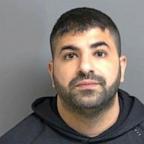Brad Keselowski: Road courses most dangerous tracks for Sprint Cup drivers
— -- LONG POND, Pa. -- Brad Keselowski considers road courses the most dangerous tracks the Sprint Cup teams compete on and says not everyone would have survived the hit he took Tuesday in testing.
Keselowski, who said a brake line was improperly installed, causing him to lose the brakes going into Turn 1 while testing at Watkins Glen, walked away from the accident where he hit a wrapped tire barrier in front of a steel guardrail while going more than 80 mph. He had been traveling around 165 mph when he tried to brake.
"I don't know that I have all the answers," Keselowski said Friday prior to practice at Pocono Raceway. "The answers I do have is that there are only so many of those hits you're going to take before someone gets killed.
"That's the way it is. It's not something I'm comfortable with, but I think as a sport there's a lot of different ways to look at it. At the end of the day, I'm still standing here. Odds are that if 100 people take that hit, one or two are not going to be standing here anymore."
It wasn't the first time a driver has plowed into the barriers in Turn 1 at The Glen, where cars likely will be faster this year because of a track repave.
"It begs to reason that maybe a change should be made in that area," Keselowski said. "I can't say that I have a specific idea at this time because more people are going to take that hit and unfortunately one of us ain't going to come back.
"That's something that the smart guys that work on that stuff are going to have to work on."
Road courses have unique challenges when it comes to runoff areas, as both amateur and hobby racers often compete on these tracks. NASCAR, which can require tracks to put up energy-absorbing walls (often SAFER barriers), evaluates the safety of every track after each event to determine if any changes are needed for its next visit.
"Tire barriers or SAFER Barriers is kind of a wash to me on those types of tracks," Keselowski said. "Preferably, we just have angles to where you can hit it with a SAFER Barrier and not worry about things.
"I understand there are some limitations there because some of these road courses run different series and so forth and they don't want to get in a situation where a minor spin doesn't damage some rich guy's $300,000 car."
Keselowski didn't seem angry when he made the comments, maintaining a matter-of-fact tone. The Team Penske driver broke his left ankle in a 2011 crash at Road Atlanta and believes the road courses are more dangerous than the high-banked superspeedways of Talladega and Daytona.
"In general, I'm not comfortable with tracks that have runoffs that lead to very harsh angles," Keselowski said. "That's certainly the situation that track has, always had it.
"The road courses remain the most dangerous tracks in motorsports for good reason because of that. ... To some point, we have signed up for a certain level of risk. That's right on the edge of what's acceptable risk. I think every driver has their own line."
Since Keselowski's 2011 accident, the Penske cars have gone through a safety overhaul, he said. They have designed a new seat. They're now using a steering wheel -- designed by a company owned by former racer and IndyCar official Max Papis -- that absorbs energy. He believed all the redesigned pieces performed well. NASCAR has also mandated a different belt package to secure the driver.
"The pedals [were] redesigned to hopefully not break my feet, which they didn't, which was great," Keselowski said. "The floorboard was redesigned with completely new-style carbon fiber, composite materials.
"We helped a company design a new seat from that time ... that is significantly safer."
Keselowski said his head and chest, he believes, did hit the steering wheel, which he said is an issue with the steering column.
"It is probably the weakest link in those type of impacts at the moment," Keselowski said. "There is always going to be one weak link, but that one in particular continues to be a pretty big issue.
"We've seen that a couple of times over the last few years where the steering wheel comes back up in your face and can do a lot of damage to your helmet, your head, etc. I'm lucky I didn't get too much of it."




